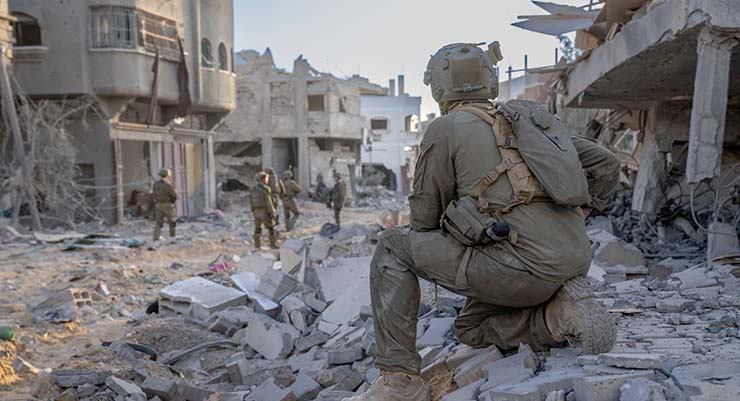
Tel Aviv: When the ongoing war between Israel and the two Iranian terror proxies in Gaza and Lebanon ends, a state investigation committee will try to answer the question – why all the intelligence that pointed to an evolving attack was not interpreted to readiness? But as the war continues there are some tactical lessons that are being addressed as the bullets and rockets keep flying.
“These initial lessons are already attracting the attention of European countries that understand that the war in Gaza is characterised by high manoeuvrability of ground forces, exactly like the one that European countries will encounter in future wars,” said a high ranking (res.) officer in the IDF that cannot be identified.
The extensive use of Iranian made armed drones by the Hamas and Hezbollah forced the Israeli defence forces (IDF) to come up with an immediate solution for the great number of attacks performed by armed drones on the Israel Merkava 4 tanks that participate in the fighting in Gaza. While these tanks are protected from anti-tank rockets by the Rafael Trophy active protection systems (APS), the upper part of the tank has no protection against drones dropping anti-tank rockets warheads from above.
The solution – an emergency instalment of protection metal nets put above the tank’s turret. These “Cope Cages” prove their efficiency but that is a make shift solution. The Israeli ministry of defence with some Israeli defence companies are now working on a version of the two existing Israeli APS that will address the new threat, currently not addressed by the existing ones.
In recent years, the Israeli air force (IAF) asked for more advanced fighter aircraft. Recently a special request was made to the US administration to expedite the supply of another squadron of 25 Lockheed Martin F-35, one squadron of Boeing’s F-15 EX and a squadron of the Apache AH-64E attack helicopter. These two fighter aircraft were in the shopping list.
The decision to purchase the new version of the attack helicopter is a direct outcome from the ongoing war. The IAF learned that a combat helicopter is an essential tool in an urban fighting where you have to hunt teams of rocket launchers while closing the sensor to shooter loop in seconds.
The major part of the Israeli made Merkava tanks in Gaza will be translated to another idea that was in the air for some time but now has been placed higher in the “to do” list of the IDF – equipping the tanks with advanced loitering weapon systems. The idea is to ask the Israeli defence companies that make this type of weapon to develop a systems that will be carried by the Merkava and will allow the tanks commander to dramatically increase the platform’s foot-print by launching a loitering weapon system that will look for targets that are not in the commander’s line of sight and destroy them.
“This will be a major improvement of the tanks capabilities mainly in very dense urban areas like Gaza,” a senior defence sources said.
The huge number of rockets launched by the Hamas and Hezbollah created a situation of “saturation” that forced Israel to act to get additional interceptors of the Iron Dome air defence systems that again achieved the amazing over 90 % kill rate. As this saturation is expected in future wars, Israel is accelerating the development of the “Iron Beam ” laser system developed by Rafael and designed to intercept aerial threats like rockets and armed UAV and armed drones.
As part of that increased effort, the prototype of the Iron Beam has been deployed for advanced testing near the Gaza strip during the ongoing war. Sources say that the initial effort is to develop an electric 100-150 kW solid state laser that is capable of intercepting rockets and missiles. The idea is to use two laser guns to create the needed power.
A source in the defence industry said that in order to have a system that will be capable of intercepting more than short range rockets and missiles, Israel will need a laser generator that will be capable of producing a 1 Mega W beam. Another idea that has surfaced with enhanced weight is to form a dedicated unit that will operate ground-ground accurate rockets.
This idea was brought up some years ago by then defence minister Avigdor Lieberman, and was put aside mainly due to opposition from the air force. According to defence sources, it was done to avoid acquisition budgets to be channelled to the proposed unit. Now, when the ongoing war proved that the target bank of the Hezbollah includes many air force bases, the idea will soon get another round of serious evaluations.
Moreover, there are lessons that will increase the usage of operational systems used by infantry soldiers. In recent fighting some of the special commando units used the Rafael FireFly personal loitering weapon system.
FireFly (Maoz) was designed for fighting within the urban arena where situational awareness is limited, the enemy is behind cover, and precision is critical. FireFly is rapidly deployed within seconds. It is portable, durable and includes a rugged airframe to withstand the harsh environment of urban combat. Its single-user operation is designed for the dismounted soldier – light, small, and agile. FireFly features a dual seeker, target tracker, homing algorithms, computer vision, safe and arm fusing mechanisms, and a rugged tablet-based HMI (Human Machine Interface).
The fighting in the dense urban zone in Gaza has attracted attention in Europe as the region feels it has to be ready for a similar type of war looking at the ongoing war in Ukraine.















